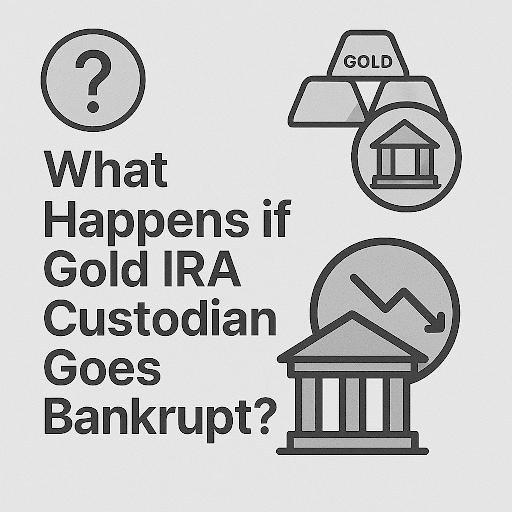Answer Summary
When a gold IRA custodian goes bankrupt, your precious metals remain safe because they are held separately from the custodian’s business assets. Federal laws require custodians to keep client assets in segregated accounts, protecting your gold investments even during financial troubles. This article explains the entire process, your legal protections, and steps to take if your custodian faces bankruptcy.
What Happens if a Gold IRA Custodian Goes Bankrupt?
The bankruptcy of a gold Individual Retirement Account custodian creates serious concerns for investors. However, understanding the legal framework and protective measures can ease these worries. Your precious metals investments have strong legal protections that keep them safe during custodian financial problems.
Legal Protections for Your Gold IRA Assets
Federal regulations create a protective barrier around your retirement assets. The Internal Revenue Service requires all IRA custodians to maintain strict separation between client funds and business operations. This means your gold coins and bars cannot be touched by creditors during bankruptcy proceedings.
Key Legal Safeguards:
| Protection Type | Description | Legal Basis |
| Asset Segregation | Client assets kept separate from custodian property | IRC Section 408 |
| Fiduciary Duty | Custodian legally bound to protect client interests | ERISA Requirements |
| Insurance Coverage | FDIC or SIPC protection for qualifying accounts | Federal Insurance Programs |
| Court Supervision | Bankruptcy court oversees asset distribution | Federal Bankruptcy Code |
The Employee Retirement Income Security Act (ERISA) adds another layer of protection. This law treats IRA custodians as fiduciaries who must put client interests first. Even during bankruptcy, this duty continues under court supervision.
The Bankruptcy Process and Your Assets
When a custodian files for bankruptcy, the process follows specific steps that protect retirement account holders. The bankruptcy court appoints a trustee to manage the failed company’s affairs. This trustee has legal duties to identify and protect client assets.
Your gold remains physically stored in approved depositories, completely separate from custodian business property. The bankruptcy trustee cannot sell or liquidate these metals to pay company debts. Instead, the court works to transfer custody to a new, qualified custodian.
Timeline of Events:
- Initial Filing – Custodian files bankruptcy petition
- Asset Freeze – Court freezes all company assets
- Client Notification – Account holders receive official notice
- Asset Inventory – Trustee catalogs all client accounts
- Transfer Process – New custodian takes over accounts
- Account Restoration – Normal operations resume
This process typically takes 3-6 months, during which your assets remain fully protected and untouchable by creditors.
Different Types of Custodian Failures
Not all custodian problems result in bankruptcy. Understanding various failure scenarios helps you prepare for different situations that might affect your retirement savings.
Business Closure Without Bankruptcy Some custodians simply close their doors due to regulatory issues or business decisions. In these cases, the company usually arranges transfers to other qualified custodians before shutting down operations.
Regulatory Shutdown Government agencies may close custodians for rule violations. The Securities and Exchange Commission or state regulators step in to protect client assets and arrange transfers to compliant custodians.
Merger or Acquisition Larger custodians sometimes buy struggling companies. Your account transfers to the acquiring company, usually with minimal disruption to your investment strategy.
Steps to Take When Your Custodian Faces Financial Problems
Early action protects your interests when custodian troubles arise. Staying informed and prepared helps you navigate these challenging situations with confidence.
Immediate Actions:
- Contact your custodian for official information
- Review your account statements carefully
- Gather all account documentation
- Research alternative custodian options
- Monitor news and regulatory announcements
Documentation to Collect:
- Recent account statements
- Original IRA establishment paperwork
- Precious metals purchase receipts
- Storage facility documentation
- Contact information for depository
Having complete records speeds up the transfer process and prevents delays in accessing your retirement funds.
Choosing a New Custodian During Transfers
The transfer process gives you the opportunity to select a more stable custodian for your precious metals IRA. This decision impacts your long-term investment success and peace of mind.
Evaluation Criteria:
| Factor | Importance | What to Check |
| Financial Strength | Critical | Credit ratings, financial statements |
| Regulatory History | High | Compliance record, violations |
| Storage Options | High | Depository locations, security measures |
| Fee Structure | Medium | Annual fees, transaction costs |
| Customer Service | Medium | Response times, support quality |
Research potential custodians thoroughly before making your selection. The Certified Gold Exchange can help clients complete the relevant documents and guide you through the evaluation process.
Insurance and Additional Protections
While legal segregation provides primary protection, additional insurance coverage offers extra security for your retirement assets. Many custodians carry insurance beyond federal requirements.
Types of Coverage:
- Fidelity Insurance – Protects against employee theft or fraud
- Errors and Omissions – Covers custodian mistakes or negligence
- Cyber Liability – Guards against digital security breaches
- Depository Insurance – Protects metals during storage
These insurance policies work together with legal protections to create multiple layers of security for your precious metals investments.
Impact on Different Types of Gold IRAs
Various gold IRA structures face different risks during custodian bankruptcy situations. Understanding these differences helps you plan appropriate protective strategies.
Traditional Gold IRAs These accounts receive full protection under standard IRA rules. The tax-deferred status continues during transfers, and you face no immediate tax consequences from custodian problems.
Roth Gold IRAs After-tax Roth contributions maintain their tax-free growth status throughout custodian changes. The five-year rule and other Roth requirements continue under new custodian management.
SEP and SIMPLE Gold IRAs Business-sponsored retirement accounts follow the same protection rules as individual accounts. Employers should monitor custodian health to avoid disruptions to employee retirement benefits.
Preventing Future Custodian Problems
Smart planning helps you avoid custodian bankruptcy situations before they occur. Regular monitoring and careful selection reduce your exposure to financial risks.
Warning Signs to Watch:
- Delayed account statements or communications
- Unusual fee increases or policy changes
- Regulatory investigations or violations
- Staff turnover or management changes
- Customer service quality decline
Due Diligence Practices:
- Review custodian financial reports annually
- Monitor industry news and developments
- Maintain relationships with multiple qualified custodians
- Keep detailed records of all transactions
- Stay informed about regulatory changes
The precious metals market offers excellent long-term growth potential when you work with stable, well-managed custodians who prioritize client protection.
Working with Professional Guidance
Navigating custodian bankruptcy requires expertise that most investors lack. Professional guidance helps you make informed decisions and protect your retirement security during challenging transitions.
Professional Services Available:
- Legal advice on asset protection rights
- Financial planning during account transfers
- Tax guidance on IRA rollover procedures
- Investment advice on precious metals allocation
- Documentation assistance for new accounts
The Certified Gold Exchange specializes in helping clients complete the relevant documents needed for smooth custodian transitions. Their experience with gold IRA regulations ensures proper handling of your valuable retirement assets.
Long-term Outlook for Gold IRA Investing
Despite occasional custodian problems, gold IRAs remain excellent vehicles for retirement wealth building. The precious metals market continues growing as investors seek inflation protection and portfolio diversification.
Market Advantages:
- Physical gold provides tangible asset ownership
- Precious metals hedge against currency devaluation
- Gold prices historically increase during economic uncertainty
- Retirement accounts offer tax advantages for long-term growth
- Professional storage ensures security and insurance protection
Smart investors view custodian bankruptcy as a temporary inconvenience rather than a reason to abandon gold investing altogether.
Final Thoughts
Custodian bankruptcy poses minimal threat to your gold IRA assets thanks to strong legal protections and segregated storage requirements. While the transfer process may cause temporary inconvenience, your precious metals remain safe throughout the proceedings. Choose financially strong custodians, maintain detailed records, and work with gold ira specialist to ensure smooth transitions when problems arise. Understanding what happens if a gold IRA custodian goes bankrupt empowers you to invest confidently in precious metals for retirement security.







